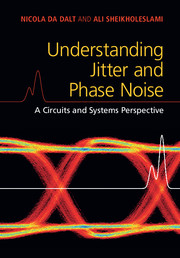Book contents
- Frontmatter
- Dedication
- Contents
- Preface
- Acknowledgments
- 1 Introduction to Jitter
- 2 Basics of Jitter
- 3 Jitter and Phase Noise
- 4 Jitter and Phase Noise in Circuits
- 5 Effects of Jitter in Synchronous Digital Circuits
- 6 Effects of Jitter on Data Converters
- 7 Effects of Jitter in Wireline Applications
- 8 Phase Noise in Wireless Applications
- 9 Advanced Concepts on Jitter and Phase Noise
- 10 Numerical Methods
- Appendix A Review of Random Variables and Processes
- Appendix B Matlab Code for Jitter Generation and Analysis
- Bibliography
- Index
2 - Basics of Jitter
Published online by Cambridge University Press: 19 February 2018
- Frontmatter
- Dedication
- Contents
- Preface
- Acknowledgments
- 1 Introduction to Jitter
- 2 Basics of Jitter
- 3 Jitter and Phase Noise
- 4 Jitter and Phase Noise in Circuits
- 5 Effects of Jitter in Synchronous Digital Circuits
- 6 Effects of Jitter on Data Converters
- 7 Effects of Jitter in Wireline Applications
- 8 Phase Noise in Wireless Applications
- 9 Advanced Concepts on Jitter and Phase Noise
- 10 Numerical Methods
- Appendix A Review of Random Variables and Processes
- Appendix B Matlab Code for Jitter Generation and Analysis
- Bibliography
- Index
Summary
In the industry as well as in academia, the concept of jitter is sometimes treated using approximations, leading to misunderstandings and possibly to systems which are not optimally designed with respect to jitter performance. This chapter lays the foundation for a thorough and clear understanding of jitter in practice.
The chapter starts by providing four fundamental definitions of jitter: absolute jitter, relative jitter, period jitter and N-period jitter. It proceeds with an overview of other jitter definitions commonly found in literature. It will be shown that these additional definitions can be expressed in terms of the four fundamental jitter definitions.
A large part of the chapter handles the important topic of jitter statistics and the estimation of key parameters such as root mean square (RMS) and peak or peak-peak values. This will lead to the classification of jitter based on its distribution, and eventually to the introduction and explanation of the concepts of deterministic jitter, random jitter and total jitter.
General Jitter Terminology and Definitions
A variety of terms are commonly used to express the concept of jitter, and several different definitions can be found in the open literature, mostly dependent on the particular background of the author or on the specific application considered. A short and incomplete list of these terms includes period jitter, cycle jitter, cycle-to-cycle jitter, N-period jitter, accumulated jitter, adjacent jitter and long-term jitter. It is not uncommon to find the same term used with different meanings by different authors, leading to possible misunderstandings and confusion.
In this chapter jitter will be defined according to the way it can be measured, at least in principle. This will not result in jitter definitions that are different from the ones already found in the literature; rather, it will put the existing definitions in a clear and solid framework. These operative definitions of jitter turn out to be very intuitive, simple and of high practical value. Since the definition is connected to a measurement process, it is easier to relate it to a specific application. And, conversely, given a specific application, this approach makes it is easier to find the relevant jitter definition.
Generally speaking, jitter is the deviation of the time instant at which a given event occurs, relative to a reference time frame, which can be chosen arbitrarily.
- Type
- Chapter
- Information
- Understanding Jitter and Phase NoiseA Circuits and Systems Perspective, pp. 15 - 42Publisher: Cambridge University PressPrint publication year: 2018



